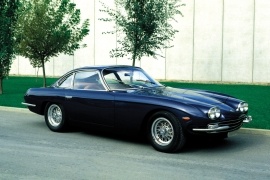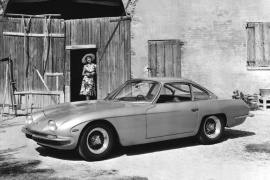LAMBORGHINI 350 GT/ 400 GT Models/Series Timeline, Specifications & Photos
First production year: 1964
Engines: Gasoline
Body style: Coupé (two-door)
Lamborghini introduced the 350 GT in 1965 and, in the same year, it offered it with a bigger engine, renamed 400.
Ferrucio's Lamborghini main target was to beat Enzo Ferrari at his own game, but for that, it had to start from something. The 350 GT was that "something." Unlike Ferrari, he didn't understand that a new engine needs a different bodywork, especially since the 350 GT was brand new.
Carozzeria Touring coachbuilders designed the car with a long hood, but they spoiled it with an uninspired pair of double headlights. Thus, they were able to lower the mid-front section. The car's grille sat lower, flanked by the chromed bumpers. The short cabin featured a raked and curved windshield and a sloped back. While the coachbuilder made the car look like a GT, the drivetrain transformed it into a supercar of those times.
Inside, the carmaker installed a bulky dashboard with the center stack extended toward the center console. It was unusual for a vehicle from those times. Its three-spoke steering wheel sported the raging-bull Lamborghini logo in the middle. The carmaker installed a bench for two in the back, but it didn't provide too much legroom.
Under the hood, the 350/400 featured a V-8 engine fed by six carburetors. Its 4.0-liter displacement provided 320 hp, which was suitable for those times. Lamborghini paired it with a five-speed manual gearbox.
The 350 GT was the car that put the Automobili Lamborghini on the map and showed that an ambitious tractor builder could produce one of the finest supercars of its era.
Ferruccio Lamborghini was a wealthy tractor builder. Its company was just 20 km (16 miles) away from Ferrari's headquarter in Maranello. He also owned a Ferrari 250 GT and complained about it to Ferrari's owner, Mr. Enzo Ferrari, who told him to stick to his tractors. That made the proud Italian mad and promised a payback. First of all, he hired Giotto Bizzarini – Ferrari's lead engineer, along with two other technicians. Now he had a team to develop a supercar, and the first result was the 350 GTV prototype unveiled in 1963 at the Turin Auto Show.
Bizzarini redeveloped the prototype with Gian Paolo Dallara, who built the best space-frame chassis from those times with independent coil-suspensions in all corners, unlike Ferrari, who still relied on a rigid axle in the rear.
Lamborghini worked with Carozzeria Touring for the bodywork, constantly pushed away by Ferrari, who preferred working with Pininfarina instead. Its last contract with the Prancing Horse brand was for four vehicles in 1956.
The result was a two-door, three-box coupe with a light, aluminum bodywork based on the Dallara's most refined space-frame chassis. Under the hood, Lamborghini installed a Bizzarini-developed V-12 engine that ran smoother than any other Ferrari engine. The 2+2 seats leather-clad interior, the complex instrument panel with dials and gauges for pretty much everything completed the Lamborghini's first supercar: the 1964 Lamborghini GT. The young carmaker from Sant'Agata Bolognese unveiled the car at the 1964 Geneva Motor Show, and the Raging Bull badge received the supercar builder status. He managed to sell 141 units in three years, even though its price tag was three times higher than for a Porsche 911 T.

